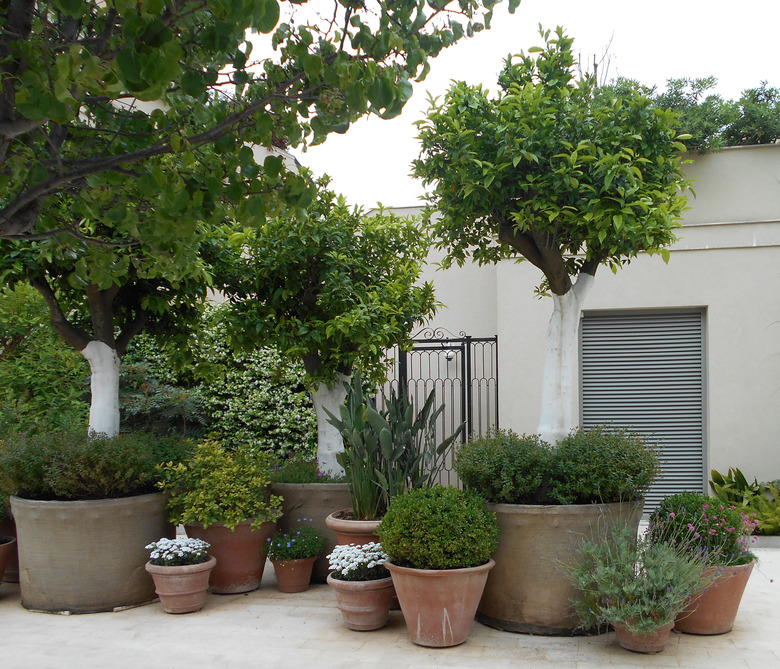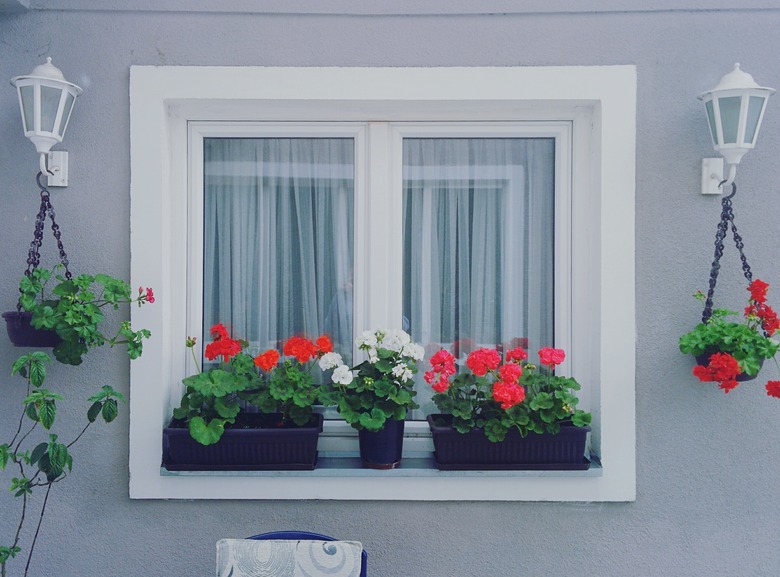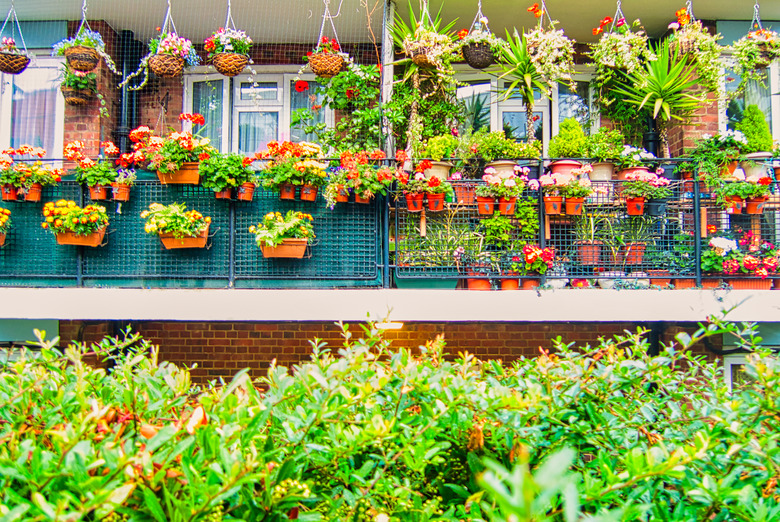The 12 Things You Shouldn't Do When Container Gardening
We may receive a commission on purchases made from links.
Container gardening is an excellent choice when a garden plot isn't an option, such as when living in an apartment with only a patio or balcony. But even if you have a large yard, growing plants in containers overcomes many landscape challenges such as compacted soil, poor drainage, and competition with tree roots. Although container gardens are easy to maintain even for the novice gardener, it's important to know what not to do to ensure the best outcome for your plants.
1. Using a Pot Without Drainage Holes
1. Using a Pot Without Drainage Holes
While just about any type of durable container can hold soil and plants, the best containers for gardening have drainage holes in the bottom. It may be tempting to skip the drainage holes simply to avoid having a mess on your driveway, patio or deck if you overwater the container plants, but the holes are necessary. If the containers are exposed to heavy rain, the water has nowhere to go and stays in the pot, which will cause root rot for most plants.
Downpours that lead to water depth above the soil line could kill the plants or wash away seeds, seedlings and sprouts. No drainage also means you'll have to dump out the water manually whenever the soil ends up under water, but the soil will still retain moisture for too long to suit most plants. To remedy these issues, either pick a different pot with holes in the bottom or use a 1/4-inch to 1/2-inch drill bit to make holes every few inches around the bottom of a medium or large plastic or resin pot. A smaller pot may only need one drainage hole. Many plastic and resin plant pots look solid on the bottom but actually have small discs on the bottom that you can push out to create appropriate drainage holes.
Tip
A saucer that fits under each plant pot also helps prevent messes around the pot. Garden centers carry a vast array of trays to fit beneath common plant pot sizes. In a pinch, pie tins or repurposed plastic lids also work. It's important, however, not to let water sit in these saucers or trays too long, because the potting mix will wick up the excess water, essentially overwatering your plants.
2. Using Terra-Cotta in Cold Weather
2. Using Terra-Cotta in Cold Weather
Some container-friendly plants, such as rosemary, last well into the cold weather months, but plant pots made of terra-cotta, concrete or ceramic often don't. Since unglazed terra-cotta and similar materials absorb moisture, they're likely to freeze and crack once the snowy season starts, especially if the pot sits on a cold surface, such as patio pavers. This also happens with terra-cotta plant saucers and trays. The pots may crack whether or not you have plants and soil in them, so even if you've emptied the pots for the season, leaving them out in the cold isn't a good idea. Place them somewhere above freezing or at the very least on a shelf in the garage out of the weather.
In weather that stays above freezing, terra-cotta, ceramic and concrete pots may be used for container gardening. Keep in mind that any pot that absorbs water may also wick water away from the soil, so you may have to water the plants more often.
3. Using Plain Garden Soil
3. Using Plain Garden Soil
While it may be tempting to use soil straight out of the yard or garden, it's not a good idea. This soil may contain weed seeds, insects or insect larvae, and it isn't right for a container for several other reasons. Even if the soil produced healthy plants in the ground or if it appears to be good soil, it's not going to perform the same in a container. Garden soil in general is too heavy and compact for container gardening, which causes drainage and aeration issues if used in a container. The end result is plants that don't grow nearly as well as they would have in the ground.
Creating a growing medium for a container garden is a lot like figuring out the proper potting medium for indoor potted plants. Succulents and similar plants prefer a sandy or sharply draining soil, while plants that are used to loads of moisture require more peat or moisture-holding materials within the mix. Tailor the potting mix to the plants you intend to put within it. A packaged quality potting mix that's suitable for vegetables (or your chosen plant type) is one option. You get what you pay for when it comes to potting soil; bargain varieties often contain debris, are far too dense and are made from clumpy soil types that aren't right for pots despite what the package label says.
If you plan to fill several large containers with potting mix, making your own blend is another option. Create a good, general-purpose container soil by adding 5 quarts each of perlite, vermiculite and a well-aged compost to 10 quarts peat moss or coir in a wheelbarrow or large tub. Add 2 cups each of builders' sand and a slow-release fertilizer. Stir in 1/2 cup lime and combine all the ingredients well. This makes enough to fill four or five medium pots or two larger 14-inch tubs, and you can store any unused portions in a lidded container.
4. Firmly Packing the Potting Mix
4. Firmly Packing the Potting Mix
Don't tamp the potting mixture firmly into the container as you prepare for planting. Even an airy, homemade potting mix can become compacted, hindering the ability for nutrients and moisture to reach the plant roots. Pour the mixture into the pot instead, leaving an inch or so of space at the top. This ensures that the potting mix stays in the pot, even during heavy rains. Gently water the soil after you add it. Its level may sink a bit, allowing you to add enough to again reach about an inch from the top.
5. Overcrowding Container Gardening Pots
5. Overcrowding Container Gardening Pots
Too many plants in one pot is like too many people trying to sit on the same seat: It just doesn't work. Many plants spread out a bit as they grow, including many types of flowers, ivies, and herbs, such as rosemary. If your container has more than enough room for the expected full size of your plant, feel free to do a little companion planting as long as there's room for each plant at full size.
Tomatoes, basil, and onions are plants that do well together in the same pot, keeping in mind that tomato and basil plants may get large and wide. For an herb assortment, try cilantro, oregano, thyme, and parsley in one pot. Various types of mint are perfect in pots with plants such as cabbage or broccoli, as the mint helps repel cabbage moths, and the container helps keep mint from spreading all over the yard.
6. Using Too-Small Pots
6. Using Too-Small Pots
If the pot is too small, the plants inside may become rootbound or simply too large for their environment. The smaller the pot, the faster the soil dries out, so even if a small pot seems right for the plant, a large pot may be better. Since the pots themselves are exposed to sunlight, they'll warm up on sunny days, which could make the soil drier and hotter than it would be in the ground. This means more watering for you and a less comfy environment for your plants.
To figure out how big of a container you'll need for your plants, consider that a 10-inch-diameter pot is good for small herbs, a 14-inch pot holds several spinach plants or a small cabbage and an 18-inch-diameter pot is wide enough for a determinate tomato plant and tomato cage or a pepper plant. Take the plant's rooting depth into consideration too. If your plant typically has deep roots, don't plant it in a 4-inch-deep pot even if the pot is wide.
7. Forgetting to Stake Tall Plants
7. Forgetting to Stake Tall Plants
Tomatoes are a container garden classic in that these plants don't seem to mind growing in containers. The downside is that these plants grow quickly and often need support, sometimes even before the tomatoes grow. The same tomato cages that work in garden plots also work well in containers wide enough to hold them. Otherwise, use tall, sturdy garden stakes and floral wire, garden twine or repurposed twist ties to loosely hold tall plants in place.
A trellis that fits into the pot is another option that works well for climbing plants. If you are using a trellis, keep the pot in an area where strong winds won't be an issue, as the wind could blow over the trellis/pot combination in extreme cases.
Another option is to place your containers beside an arbor, using the uprights on both sides of the arbor as supports for your climbing plants.
8. Tying Plants Tightly to Stakes
8. Tying Plants Tightly to Stakes
A somewhat loose loop of twine or a twist tie offers just the right amount of support to keep plants from leaning too far from their stakes. Tying them too tight could harm the plant. If the tie is too tight, the growing plant won't be able to move through the fastener, which could cut into the stem or make it bend beneath the tight loop. Plants need room to grow, including in the vertical space. The loose loop should be placed beneath stems and leaves rather than above them, as it could impede their growth otherwise.
9. Mixing Sun- and Shade-Loving Plants
9. Mixing Sun- and Shade-Loving Plants
Plants have different needs. Some love full sun, and others wither in full sun. Be sure the plants you place together in the same pot have the same needs as far as sunlight and water are concerned. Also, keep an eye on each container's location regarding the amount of direct sunlight received on an average clear day. One of the best things about container gardening is that even in a limited-space scenario, such as a balcony container garden, you can move around the containers as needed to get more sun or more shade if your plant dictates it.
If you think you'll have to move containers around during the day or from time to time, opt for container sizes and types that are easy to move. A large concrete planter, for instance, is heavy even without soil, plants and water in it. If the planter is heavy, a plant dolly or a stand on wheels makes it easier to move around containers as needed.
10. Forgetting to Water
10. Forgetting to Water
Container potting mix usually dries out faster than in-ground soil, especially on hot, sunny days, so you should plan on checking the pots more frequently than you would an in-ground garden bed. Instead of watering just until the top of the soil is wet, water dry potting medium enough so excess liquid runs out the holes in the bottom of the container. On extremely hot days, you may need to water plants in small pots twice. Of course, when the potting medium feels damp or soggy, you can skip watering.
11. Forgetting to Fertilize
11. Forgetting to Fertilize
Plants in pots don't have the luxury of accessing all the nutrients found in the ground soil, so they may need to be fertilized more often than plants in the ground. Once the plant has been in its pot for a month or longer, use an organic liquid fertilizer designed for vegetables and herbs (if that's what you're growing) every one to two weeks or as directed on the fertilizer label. If your potting mix already has some form of fertilizer in it, you may not need to fertilize as often.
12. Leaving Pots Directly on Wood
12. Leaving Pots Directly on Wood
While a small container garden looks nice on a deck, porch or even on a wooden bench or table, pots placed directly on the wood may harm the wood over time due to water drainage. Even a saucer beneath the plant pot could overflow during heavy rains. Raise up the planters a little with pot risers, which are small blocks that serve as "feet" to keep the pots elevated. This helps prevent mildew or wood damage that could occur otherwise, allowing water beneath the pot to evaporate.
No matter where you do your container gardening, it's a good idea to move the pots every week or so — even by just a few inches — to prevent rings or marks on the underlying surface.



